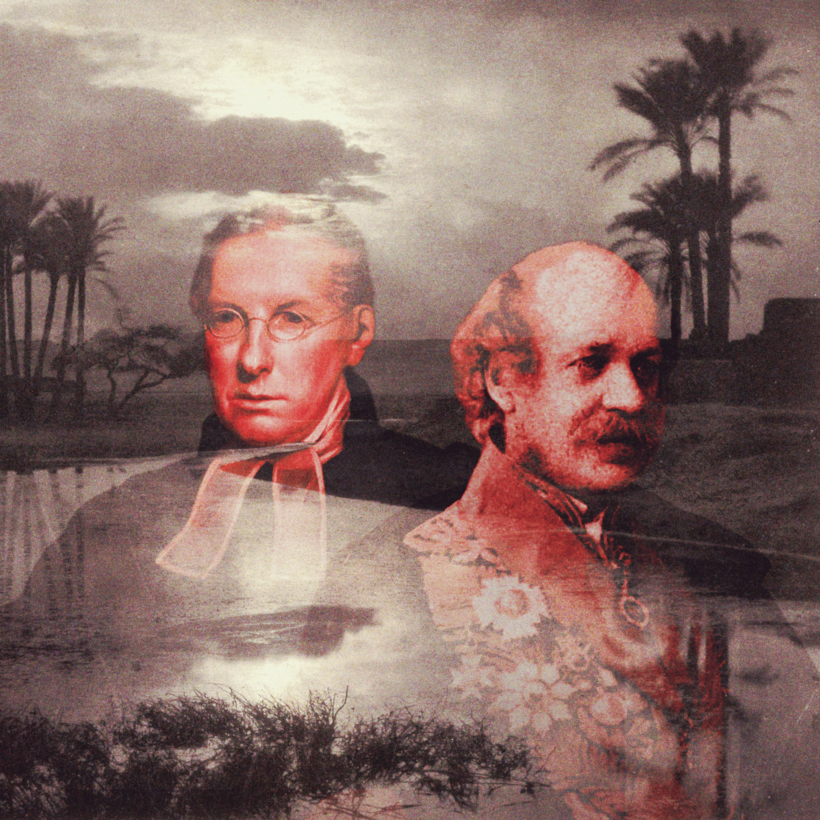Great discoveries and epic rivalries were par for the course in the heated intellectual atmosphere of Victorian England. Think of Charles Darwin and Alfred Russel Wallace, the two giants of evolutionary theory, sparring over the mechanisms of natural selection, or John Speke and Richard Burton, the African explorers, feuding bitterly over who deserved credit for finding the source of the Nile.
But when I started research on my new book, The Mesopotamian Riddle: An Archaeologist, a Soldier, a Clergyman, and the Race to Decipher the World’s Oldest Writing, I was surprised to learn that the most intense rivalry of the era had raged in the usually sedate field of philology.
The competition between Henry Rawlinson and Edward Hincks to decipher the writings of ancient Babylon and Assyria was a knockdown, drag-out brawl that appalled bystanders in the 1840s and 1850s. Laid out in letters, diaries, and news accounts in the British Library and the Royal Asiatic Society, this tale of backstabbing and betrayal made the Speke-Burton quarrel seem almost polite by comparison.
The two antagonists couldn’t have been more different. The son of a prosperous landowner in southern England, Rawlinson joined the East India Company at 17 in 1827 and shipped out to Bombay. Over his next three decades in Central Asia and the Near East, he led cavalry charges against Afghan warriors in Kandahar, hunted lions in the Mesopotamian desert, served as the East India Company’s British representative in Baghdad, and made daredevil climbs up cliffs in western Persia to copy cuneiform inscriptions.
In 1819, at age 27, Hincks abandoned a promising academic career in theology and philosophy at Trinity College in Dublin to become a pastor in the Church of Ireland. He rarely left his rural village in Ulster over the next 40 years, spending his time delivering sermons, caring for his invalid wife, complaining about his meager salary, and studying ancient writings in his rectory.
In 1846, Hincks began surveying cuneiform inscriptions on a limestone slab excavated from the ruins of Babylon and displayed at the East India Company headquarters on Leadenhall Street, in London. He claimed that he had identified the signs for King Nebuchadnezzar, the powerful Babylonian monarch who had destroyed Jerusalem and the Kingdom of Judah in 587 B.C.E. and deported much of the Jewish population.
Meanwhile, Rawlinson, who was living in Baghdad, had access to a flow of inscribed relics that his friend the archaeologist Austen Henry Layard was shipping down the Tigris River by raft from the Assyrian palaces at Nineveh, destined for the British Museum, in London. But Rawlinson struggled to make sense of them, and when he heard that Hincks had scored the first major breakthrough in translating the ancient Mesopotamian language, he worried desperately that he was being left behind.
After that, the relationship between the two ambitious men—who would meet only twice, both times in 1850, but kept a close eye on each other’s progress—grew increasingly worse. As Hincks announced one discovery after another—such as recognizing that Assyro-Babylonian writing combined phonetic characters and logograms, and that the language closely resembled Hebrew—Rawlinson began behaving like an ill-tempered child. He expressed disbelief that a “strange country parson” had given him “the go-by.” When he learned in 1852 that Layard had traveled to Hincks’s village to examine inscriptions with him, he exploded in a jealous rage.
The Irishman was “an unscrupulous … antagonist,” he wrote to a confidant, vowing to carry “a war” into the “enemy camp.”
Hincks, who could be just as prickly, accused Rawlinson of trying to steal credit for his discoveries and ridiculed some of his findings. In one case, Rawlinson claimed that an inscription found near Babylon designated the exact spot where the Tower of Babel had been built “2,940 years” before the reign of Nebuchadnezzar. Hincks dismissed Rawlinson’s reading as a fantasy.
But it was in 1853, when Hincks landed a coveted job deciphering inscriptions at the British Museum, that the rivalry took a dark turn. After working with the collection for a year, Hincks was abruptly told that his contract wouldn’t be renewed. He was certain that Rawlinson had sabotaged him and deprived him of the much-needed income. (Rawlinson never admitted his role in the firing, but he had warned that the museum was his own “game reserve” and called Hincks a “poacher.”) Worse, Hincks’s black spiral notebooks, in which he recorded all his decipherments and explanatory notes, mysteriously disappeared one day from his museum workroom. Much later he learned that a curator had swiped the precious journals and sent them to Rawlinson in Baghdad. It was an astonishing act of betrayal.
The often vitriolic competition between Hincks and Rawlinson carried on into the 1860s. But after Hincks died, in 1866 at 74, Rawlinson did something uncharacteristic: he gave his support to a petition for a government pension for Hincks’s three daughters, who had been left penniless by their father’s death. Perhaps he was motivated by remorse for the way he had treated the clergyman; or maybe he was just worried about his reputation.
More than a century would have to pass before Assyriologists reached a consensus about which of the two rivals could be considered the superior decipherer. Long lauded by the academic establishment in both the United States and Great Britain as “the Father of Assyriology,” Rawlinson has largely ceded that honor to the reclusive parson of Ireland.
Joshua Hammer is a freelance magazine journalist and the author of six books

